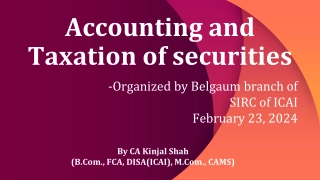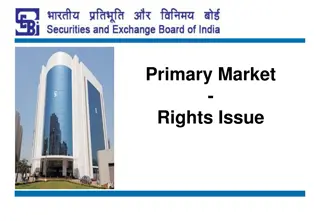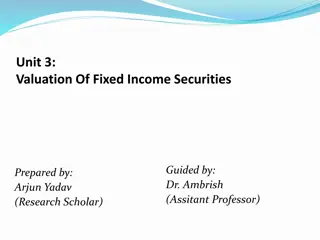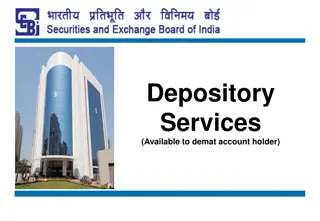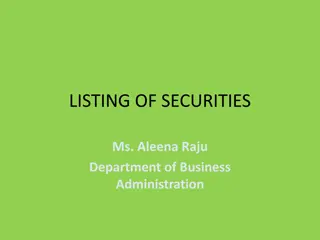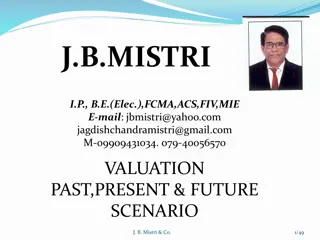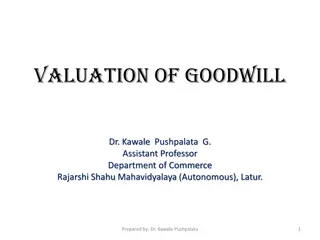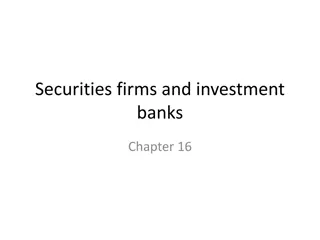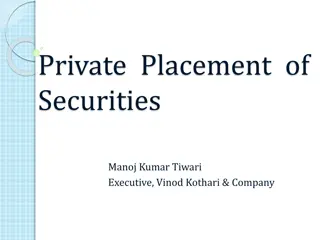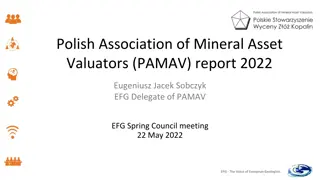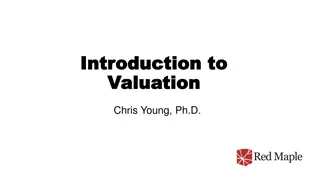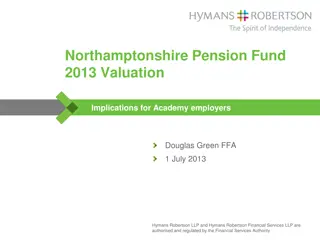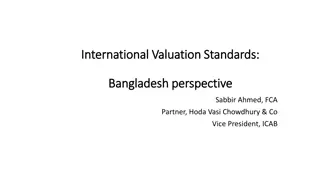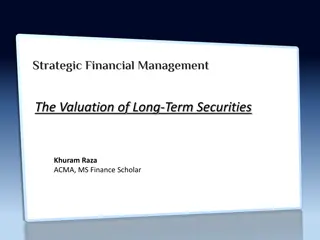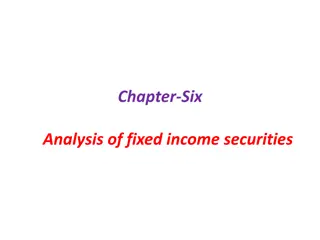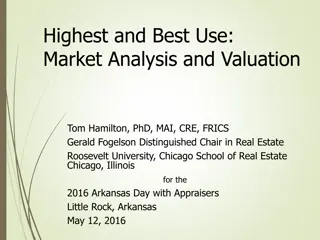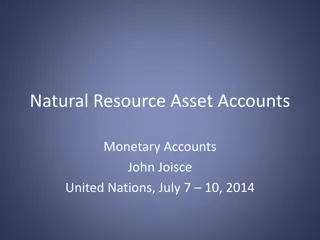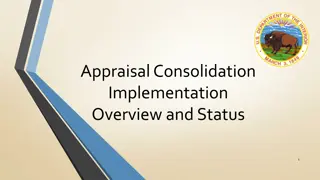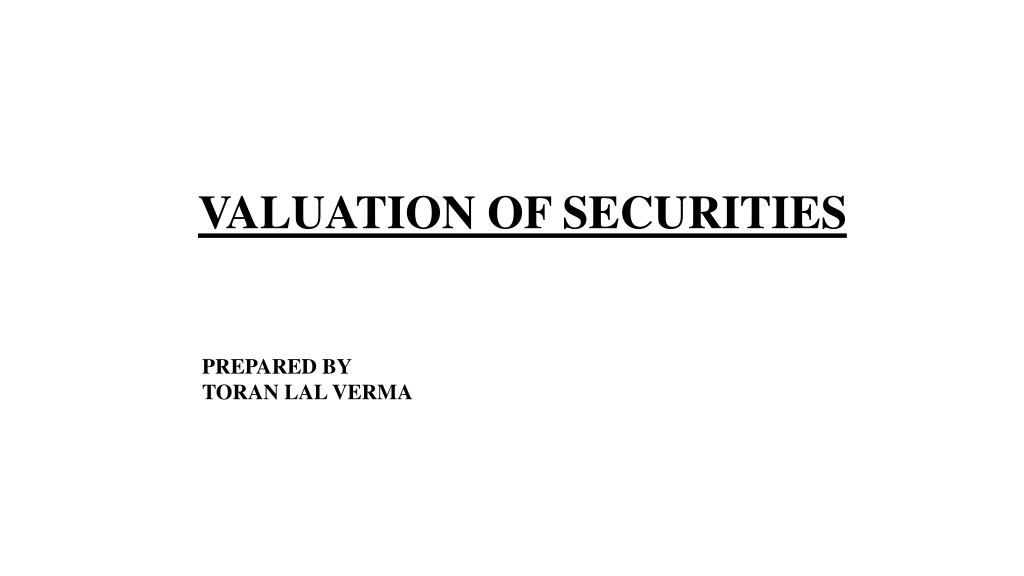
Understanding Valuation of Securities and Bonds
Learn about the valuation process of securities including equity shares, preference shares, and bonds. Explore different methods like book value, market value, liquidating value, and more. Understand the concept of capitalized value in security valuation. Dive into the valuation of bonds and debentures with a practical example.
Uploaded on | 0 Views
Download Presentation

Please find below an Image/Link to download the presentation.
The content on the website is provided AS IS for your information and personal use only. It may not be sold, licensed, or shared on other websites without obtaining consent from the author. If you encounter any issues during the download, it is possible that the publisher has removed the file from their server.
You are allowed to download the files provided on this website for personal or commercial use, subject to the condition that they are used lawfully. All files are the property of their respective owners.
The content on the website is provided AS IS for your information and personal use only. It may not be sold, licensed, or shared on other websites without obtaining consent from the author.
E N D
Presentation Transcript
VALUATION OF SECURITIES PREPARED BY TORAN LAL VERMA
VALUATION Valuation is the process of determining the worth of an asset at zero period of time. Securities here include Equity share, Preference share and Bond/Debenture. Value of security is closely related to the present value of the future cash streams. Called as Intrinsic Value. The Value realized at the end of maturity of the security is Terminal Value. Different Assets may be valued differently with different perspective.
Securities/Assets could be valued on the basis of following 1. Book Value: It is an accounting concept. It is the difference between book value of total asset and book value of total External liability. Also known as net worth/Shareholders fund. 2. Market Value: The current price at which the security can be sold is market price. 3. Going Concern Value: The amount a business concern could realize if the business is sold as an operating unit is known as going concern value. Going Concern Value depends upon the ability to generate sales and profits in the future. 4. Liquidating Value: The amount which the owners would realize after having liquidated the business it firms liquidation value. It may also be zero. 5. Replacement Value: It is the amount which is required to replace the existing assets.
6. Capitalized Value: The Capitalized value of a financial asset is the sum of present value of cash flows from an asset. It is also known as Economic Value. It is the most relevant concept of valuation of securities. We are going to discuss this concept only.
VALUATION OF BOND/DEBENTURES Debentures are issued by corporates. Bonds are Mainly issue by government and quasi government agencies. It carries fixed interest rate i.e. Coupon rate. The Present Value of Bond ? (1+?)? + (1+?)? P.V. = Present Value C = Coupon or interest for the time t T.V. = Terminal Value repayable at maturity (at par, premium or discount) r = Internal rate of return or cost of capital n = number of years to maturity ?? P.V. =
An investor purchases a bond whose face value is 1000, maturity period is 5 years and coupon rate is 7%. The required rate of return is 8%. What amount he should be willing to pay now to purchase the bond if it matures at par.
An investor purchases a bond whose face value is 1000, maturity period is 5 years and coupon rate is 7%. The required rate of return is 8%. What amount he should be willing to pay now to purchase the bond if it matures at par. Solution ?? ?? ?? ?? ?? ?? (?+?)? + (?+?)? + (?+?)?+ (?+?)?+ (?+?)?+ P.V. = (?+?)? P.V. = ?? ?? ?? ?? ?? ???? (?+.??)? (?+.??)? + (?+.??)? + (?+.??)?+ (?+.??)?+ (?+.??)?+ P.V. = 64.81 + 60.01 + 55.57 + 51.45 + 47. 64 + 680.58 P.V. = 960.06
If half yearly calculation is to be done Number of years must be multiplied with 2 Coupon payment must be divided by 2 Coupon rate must be divided by two Coupon = 70/2 =35 r = 0.8/2 = 0.4 N = 10 years ?? ?? ?? ?? ?? ?? ?? ?? = (?+.?.?)? + ?? (?+.??)?+ (?+.?.?)? + ?? (?+.??)??++ (?+.??)? (?+.??)?+ (?+.??)?? (?+.??)?+ (?+.??)?+ (?+.??)?+ (?+.??)?+ ????
VALUATION OF ZERO COUPON BOND The debt instrument which do not pay any interest. But issue at discount and redeemed at par. So the present value of redemption amount/terminal amount will be the value of zero coupon bond. ?? P.V. = (1+?)?
YIELD TO MATURITY The yield to maturity, book yield or redemption yield is rate of return earned by an investor who purchases bonds and holds it till maturity. Yield to maturity is the discount rate at which the sum of all future cash flows from the bond (coupons and principal) is equal to the current price of the bond. Same as internal rate of return.
Valuation of Preference 1. Value of Redeemable preference share is determined same as Bonds. ??? (?+?)? + ??? (?+?)? + ??? (?+?)?+ ??? (?+?)?+ ??? (?+?)?+ ?? P.V. = (?+?)? 2. Value of Irredeemable preference share is determined by the following formula: Po =?? ??
VALUATION OF EQUITY On the basis of Accounting information On the basis of Dividend On the basis of Earnings
VALUATION OF EQUITY ON THE BASIS OF ACCOUNTING INFORMATION 1. Book Value Approach: it is simply the firms net worth divided by Number of equity shares. Net Worth = Equity share capital+ reserves and surplus- accumulated losses Net Worth = Total asset Total External Liabilities net worth Book Value of Equity = ????? ?? ?????? ????????????
2. Liquidation Value Approach: The liquidation value of an equity share is the amount of cash that would be received from the company if all its assets are sold and all its liabilities are paid. liquidation value =????? ???????? ???? ?????? ??????? ?????? ?? ??? ???????? ?????? ?? ?????? ? ??? ?????
VALUATION OF EQUITY ON THE BASIS OF DIVIDEND 1. Single Period Valuation Model: When equity share is held by investor for just one year. ?? (?+?)? + (?+?)? ?? Po =
Problem: Bright Limited is expected to declare a dividend of Rs. 5 and reach a price of Rs. 70 a year. What is the price at which the equity share would be sold to the investors now if the required rate of return is 14%. Solution: ?? (?+?)? + (?+?)? Po = (?+???)? ? ?.?? + ?.?? Po =?.?? + ??.?? Po = 65.80 ?? Po = ? ?? (?+.??)? + ?? Po =
Multiperiod Dividend Valuation Model When an investor holds an equity shares for n number of year, the value of share is the present value of all future stream of dividends. ? (?+?)? + ? ? ? ? (?+?)? + (?+?)? . (?+?)?+ (?+?)?+ P0 =
ON THE BASIS OF GROWTH OF DIVIDEND 1. Zero growth in dividend or constant dividend ? ?? Po = 2. Constant growth in dividend ? Po = ?? ?
Suppose a firm pays a dividend of 20% on the equity shares of face value of rs. 100 each. the required rate of return of the investor is 15%. Find out the value of equity shares given that 1. the dividend rate is expected to remain same and 2. the dividend rate is expected to grow constantly at 3% Solution ? ?? 100 Po =20 ? Po = Po = ?? ? 100 20 15 .03 100 Po = 133.60 15 100 Po = Po = 133.33
VALUATION OF SHARES ON THE BASIS OF EARNINGS 1. Walter Model 2. Gordon Model 3. P/E Ratio
P/E RATIO P/E Ratio =??? ??? EPS =??????? ??? ??????? ? ??? ????? ?????? ?? ?????? ? ??? ?????? Value of equity Share = EPS P/E Ratio
Capital Asset Pricing Model The capital asset pricing model (was developed in 1952 by Harry Markowitz. It was later adapted by other economists and investors, including William Sharpe, Merton miller, Jack Treynor, John Lintner. Sharpe, Markowitz and Merton Miller jointly received the 1990 Nobel Prize in Economics for this contribution to the field of financial economics CAPM describes the relationship between an investor s risk and the expected return. It is designed to help model the pricing of higher-risk securities. In other words, we can say that it is expected rate of return on high risk securities According to the CAPM theory, the expected return of a particular security or a portfolio is equal to the rate on a risk-free security plus a risk premium.
ASSUMPTIONS OF CAPM 1. The market is perfect: there are no taxes, there are no transaction costs, securities can be bought and sold freely and easily, information is available freely and easily. 2. The investors are risk averse i.e. they try to avoid risk. 3. Investors have homogenous expectations of returns. 4. Investors can borrow and lend freely at the riskless rate of interest. 5. All investors aim to maximize economic value.
FARMULA: THE BRAHMASTRA Ki = Rf+ (Rm Rf) Where, Ki = the required return on security Rf = Risk free rate of return = The beta (Risk) of the security Rm = Market rate of return Rm Rf = Risk Premium The Capital Asset Pricing Model (CAPM) is a model that describes the relationship between expected return and risk of investing in a security. It shows that the expected return on a security is equal to the risk-free return plus a risk premium, which is based on the beta of that security.
Overall stock market has a beta of 1.0 1. > 1 =high volatility, high risk, aggressive security, high return 2. < 1 = Low volatility, low risk, defensive security, low return 3. = 1 = same volatility as the market .
The current interest rate on Indore municipal bond is 3%. And the NSE Nifty is expected to bring in returns of 9% over the next year. Mr. Manish Pratap wants to purchase shares of RIL and he has learned that the beta of RIL is 1.9. What rate of return should Mr. Kanojia expect from the shares of RIL.
Students: Sir Numerical to Padh lenge, MCQ ka kya kare Toran sir:
When Teacher takes attendance only after 15 minutes of teaching Students :
When teacher shows you your attendance and your attendance is less than 75%.....

